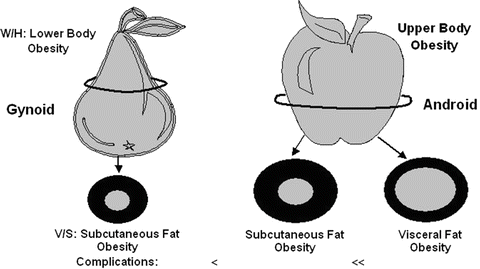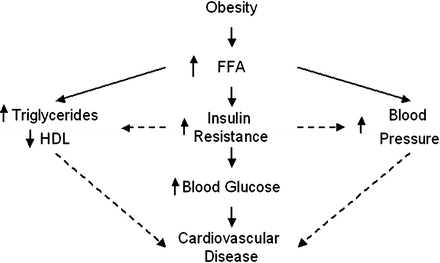In order to determine the appropriate risk of metabolic syndrome, we should use Risk-Adjusted BMI, which takes the degree of central obesity into account. Waist measure or waist to hip ratio provides the measure of central obesity. If you review the risk classification chart below, you will see by combining her BMI and central obesity, she has as much metabolic risk as someone in class II obesity (BMI 35.0–39.9) (Table 50.1).
Table 50.1
Classification by BMI and waist circumference with associated risk for type-2 diabetes mellitus (T2DM), hypertension, and cardiovascular disease (CVD)
Classification | BMI | Waist | Circumference |
|---|---|---|---|
Men <40″, Women <35″ | Men >40″, Women >35″ | ||
Overweight | 25.0–29.9 | Increased | High |
Obesity Class I | 30.0–34.9 | High | Very high |
Obesity Class II | 35.0–39.9 | Very high | Very high |
Obesity Class III | >40.0 | Extremely high | Extremely high |
Clinical Diagnosis of the Metabolic Syndrome
Central obesity is a major risk factor for metabolic syndrome. An android or an apple-shaped body weight distribution increases this risk compared to a pear body weight distribution as it is associated with increased visceral adiposity (Fig. 50.1).


Fig. 50.1
Classification of obesity according to fat distribution
Based on her waist circumference and laboratory values listed, she has all of the features of MetS. The definition was recently defined in a joint scientific statement by the International Diabetes Federation Task Force on Epidemiology and Prevention, National Heart, Lung, and Blood Institute, American Heart Association, World Heart Federation, International Atherosclerosis Society, and the International Association for the Study of Obesity. In this concerted effort to “harmonize” the definition, one major change was making central obesity just one of five components in making the diagnosis of MetS and not a prerequisite. The diagnosis of MetS is made when a patient has three of the five risk factors [1]. Because of well-described ethnic variations in the relationship of waist circumference with visceral adiposity, ethnic specific cut-offs based on population studies are recommended for use (Table 50.2).
Table 50.2
Criteria for clinical diagnosis of the metabolic syndrome
Measure | Categorical cut-off point |
|---|---|
Elevated waist circumference | Population and country specific definitiona |
Caucasian Men ≥94 cm, Women ≥80 cm | |
Asian and Ethnic Central and South American Men ≥90 cm, Women ≥80 cm | |
Elevated triglycerides | ≥150 mg/dl (1.7 mmol/l) |
Reduced HDL-C | <40 mg/dl (1.0 mmol/l) in males; <50 mg/dl (1.3 mmol/l) in females |
Elevated blood pressure | Systolic ≥ 130 and/or diastolic ≥ 85 mmHg |
Elevated fasting glucose | ≥100 mg/dl (5.5 mmol/l) |
Obesity and Insulin Resistance
So, what role does obesity play in the metabolic syndrome? Obesity is a state of excess of body fat resulting in increased level of free fatty acid (FFA). Increased levels of FFA contribute to inhibition of insulin stimulated glucose utilization in muscle and stimulation of hepatic glucose production [2]. Visceral adipocytes are considered to be more lipolytically active than subcutaneous adipocytes and contribute to insulin resistance and its consequences (Figs. 50.2 and 50.3) [3].






